The Power of B2B Customer Journey Mapping: Unlocking Growth in the Digital Age

Let’s be brutally honest for a moment: the B2B buying journey isn't what it used to be. Remember the good old days when a prospect would pick up the phone, speak to a sales rep, and the process was, well, pretty linear? Forget about it. Those days are long gone. Today, the path your B2B buyers take is a dynamic, often complex odyssey, filled with digital detours, multiple stakeholders, and a whole lot of independent research.
Here’s the cold, hard truth: many B2B businesses are still operating with a blindfold on. They're spending millions on marketing campaigns and sales strategies, only to wonder why leads aren't converting, customers are churning, and their growth seems stuck in neutral. The common culprit? A gaping disconnect between how businesses think their customers behave and how they actually behave. This misalignment leads to missed opportunities, frustrated buyers, and ultimately, a significant hit to your bottom line.
But what if you could literally see every step your potential client takes? What if you could anticipate their needs, understand their frustrations, and deliver exactly what they need, precisely when they need it? That’s where B2B customer journey mapping steps in. Think of it as your ultimate GPS for growth. It’s not just a fancy diagram; it’s a strategic imperative that allows you to visually represent every interaction a customer has with your brand, from that very first inkling of a problem to becoming a loyal advocate.
In this comprehensive guide, we're going to pull back the curtain on why B2B customer journey mapping isn't just a "nice-to-have" but a non-negotiable for modern businesses. You’ll discover how it drives tangible results—think explosive growth, iron-clad retention, and unparalleled efficiency. And here’s a pro tip: this isn’t just theoretical fluff. Ready to stop guessing and start growing? Let’s map out your success.
What Exactly is B2B Customer Journey Mapping, and Why Now?
So, you’ve heard the term "customer journey mapping" thrown around. Maybe you've even seen a few examples that look like complicated flowcharts. But let's clarify what this truly means in the B2B world, and more importantly, why it’s suddenly become the hottest topic in growth circles.
Defining the B2B Customer Journey Map
At its core, a B2B customer journey map is a visual representation – often a diagram or infographic – that illustrates the entire experience a business buyer has with your company. It’s a tool built on empathy, designed to help you step into your customers' shoes. It’s not just about tracking clicks and conversions; it's about understanding the why behind their actions, their emotions, their pain points, and their goals at every single touchpoint.
Think about the key components:
- Personas: Who are your ideal customers? Not just job titles, but their roles, challenges, motivations, and the decision-making unit they operate within.
- Stages: The distinct phases of their journey (more on this in a bit).
- Touchpoints: Every single interaction, online or offline, they have with your brand (website, emails, sales calls, webinars, support tickets, even word-of-mouth).
- Pain Points: Where do they get stuck? What frustrates them?
- Emotions: How do they feel at each stage? Confused? Excited? Frustrated?
- Goals: What are they trying to achieve at each point?
- Internal Processes & Ownership: Which of your departments or teams are responsible for each part of the journey?
Pro Tip: Unlike B2C journeys, which are often quick and individual, B2B journeys involve multiple stakeholders, complex internal discussions, and significantly longer sales cycles. Mapping this multi-layered interaction is crucial. If you want to dive deeper into the nuances of defining your target audience and understanding their needs, take a look at our guide on how to conduct keyword research for your new website with Semrush, as it helps uncover the language and questions your ideal customers are using.
The Evolving B2B Buyer: Why Traditional Approaches Fall Short
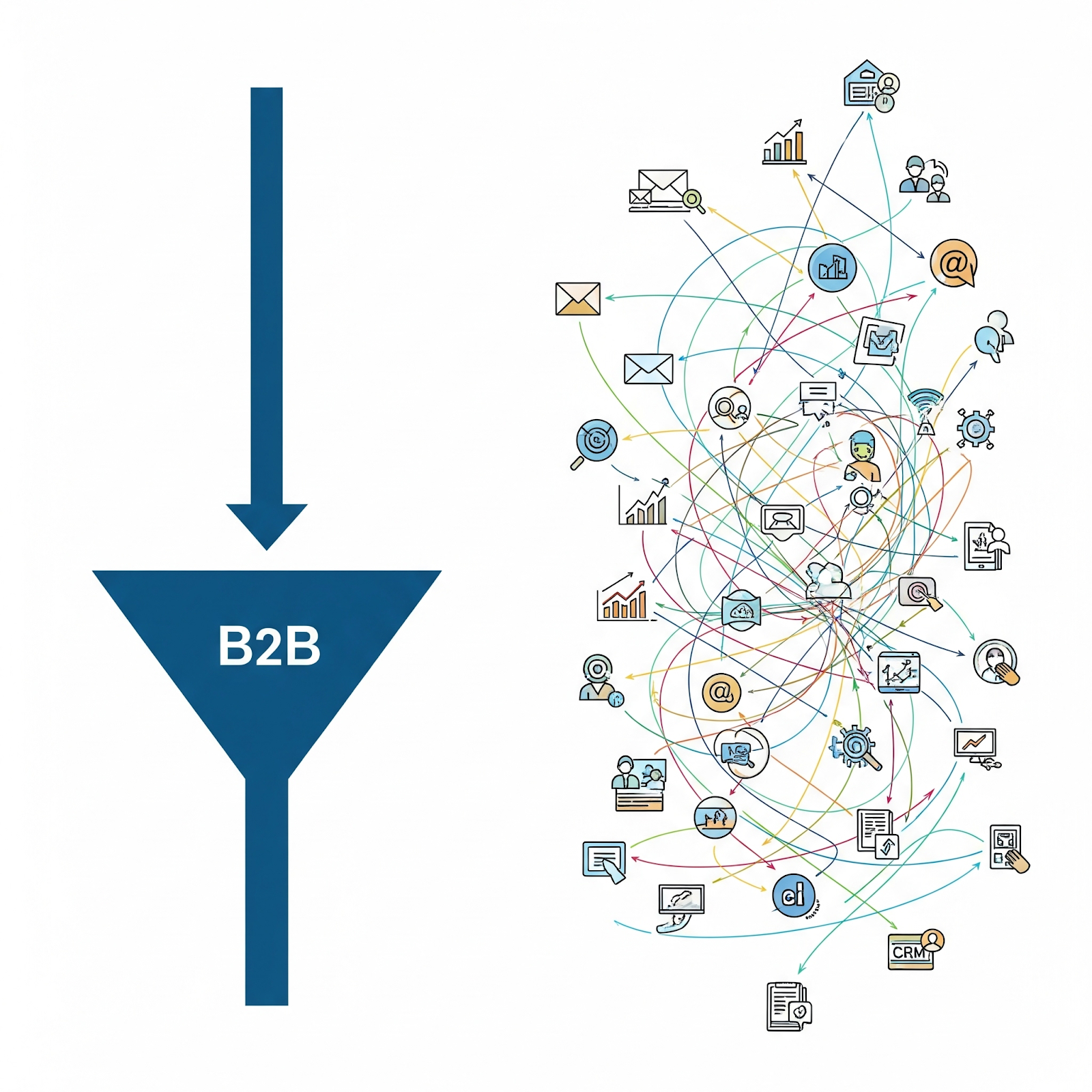
The reason B2B customer journey mapping has become so critical boils down to one simple fact: the B2B buyer has fundamentally changed.
- The Rise of the Digital Native: Did you know that Gen Z and Millennials now make up a significant portion of B2B purchasing decisions? These aren't your grandpa's buyers. They expect a personalized, seamless, and digital-first experience, much like they get in their consumer lives. In fact, Gartner predicts that 80% of B2B sales interactions between suppliers and buyers will occur in digital channels by 2025. If your journey isn’t optimized for this, you’re already behind.
- The Self-Directed Buyer: B2B buyers are empowered. They’re doing their homework, and then some. Before even considering a sales call, they’re engaging in extensive online research – we’re talking 12+ searches and consuming 13+ pieces of content, on average. They're seeking answers, vetting solutions, and building an informed opinion long before they ever raise their hand. If your content isn’t addressing their needs at every stage, you're invisible. This is where data-driven B2B marketing truly shines, allowing you to create content that resonates.
- The Omnichannel Expectation: Your customers aren't sticking to one channel. They might start on your website, jump to a LinkedIn discussion, watch a YouTube demo, get an email, and then finally call a sales rep. They expect a consistent, connected experience across all these touchpoints. A disjointed journey is a frustrating journey.
Beyond the Sales Funnel: The Loop of Loyalty
For years, B2B businesses were obsessed with the "sales funnel." Awareness at the top, conversion at the bottom. But here's the reality check: the journey doesn't end at the purchase. True growth comes from repeat business, renewals, and enthusiastic referrals.
This is why we've shifted from a linear "funnel" to a more cyclical "customer journey" that encompasses the entire loop of loyalty. It includes critical post-purchase stages like onboarding, product adoption, ongoing support, retention, and ultimately, advocacy. Ignoring these stages is like filling a bucket with a hole in the bottom – you’ll never truly grow. Focusing on customer retention is actually more cost-effective than constant acquisition. If you're struggling with maximizing your ROI, our guide on 10x your B2B marketing ROI with these proven tactics can offer valuable insights.
By mapping this entire loop, you're not just optimizing for sales; you're building relationships that last, turning customers into champions, and creating a sustainable engine for growth.
The Undeniable Benefits: Why B2B Customer Journey Mapping is a Growth Engine
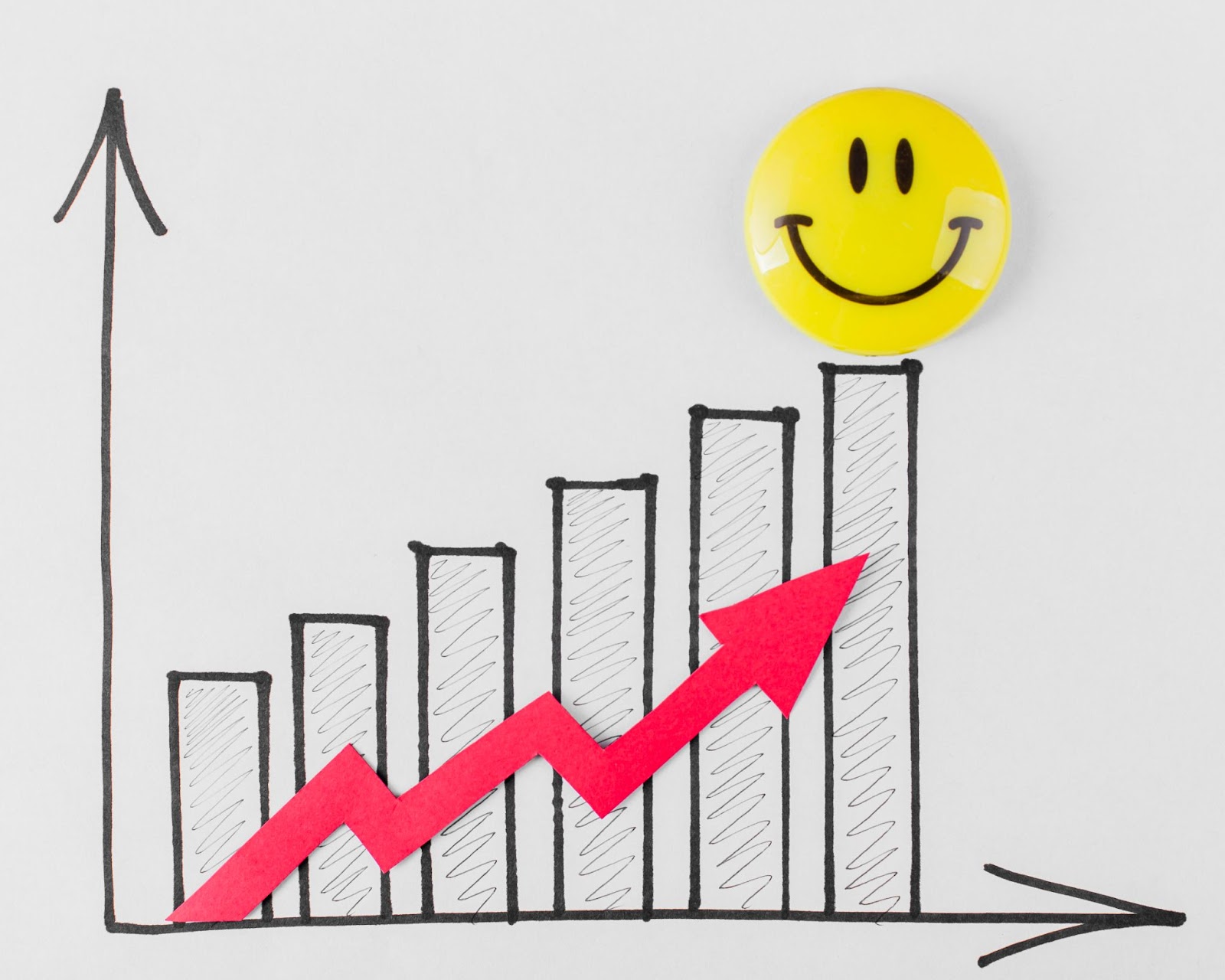
Okay, so we’ve established that the B2B buyer has changed, and understanding their journey is more crucial than ever. But what’s in it for your business? How does spending time mapping out these interactions actually translate into tangible results for your bottom line? Let me tell you, the benefits are far from theoretical – they're a direct pathway to becoming a market leader.
Enhanced Customer Experience (CX) & Satisfaction
Imagine this: your potential customer lands on your website, effortlessly finds the exact solution they need, receives a perfectly timed email with a relevant case study, and then has a seamless conversation with a sales rep who already understands their specific pain points. Sounds like a dream, right? That’s the power of optimized customer experience, and it starts with mapping.
By meticulously charting the customer journey, you can pinpoint every single moment of friction. Is your website navigation clunky? Are your sales reps receiving incomplete information? Is the onboarding process confusing? These seemingly small annoyances can quickly add up, leading to frustration and, eventually, lost business. A well-mapped journey allows you to:
- Identify and eliminate friction points: Think of it like smoothing out a bumpy road for your customer.
- Create seamless transitions: Ensure that moving from a marketing-qualified lead to a sales-accepted lead feels like a logical progression, not a jarring handover.
- Pro Tip: A clearer, more intuitive onboarding journey can dramatically reduce early-stage churn and boost product adoption. When customers understand how to use your solution quickly and effectively, they're more likely to stick around. Businesses that prioritize personalization often see impressive growth – some studies indicate that businesses with personalized marketing grow 60% more than those that don't. That’s a significant edge in a competitive market.
Optimized Lead Generation & Conversion Rates
Here’s where journey mapping directly impacts your sales pipeline. When you truly understand what your B2B buyer is thinking, feeling, and doing at each stage, you can craft incredibly precise and impactful marketing and sales strategies.
- Targeted Content Creation: No more guessing games. You'll know exactly what type of content (blog posts, whitepapers, webinars, case studies, demos) is most effective at each stage. For instance, in the awareness phase, your prospects might need educational content addressing their general business problem. In the consideration phase, they'll want comparative analyses and deep dives into solutions. This allows you to produce the right message, at the right time. For more on creating lead-generating content, check out our guide on how to create B2B content that generates leads and sales.
- Improved Lead Nurturing: Beyond just generating leads, you'll be able to nurture them far more effectively. By anticipating their questions and objections, you can build automated email sequences and sales playbooks that guide prospects smoothly from initial interest to a qualified opportunity.
- Identify High-Impact Touchpoints: Which interactions truly move the needle? Is it a personalized demo, a well-timed follow-up email, or a compelling customer testimonial? Journey mapping reveals these critical moments, allowing you to double down on what works and optimize what doesn't.
Key Stages of the B2B Customer Journey (And What to Map at Each)
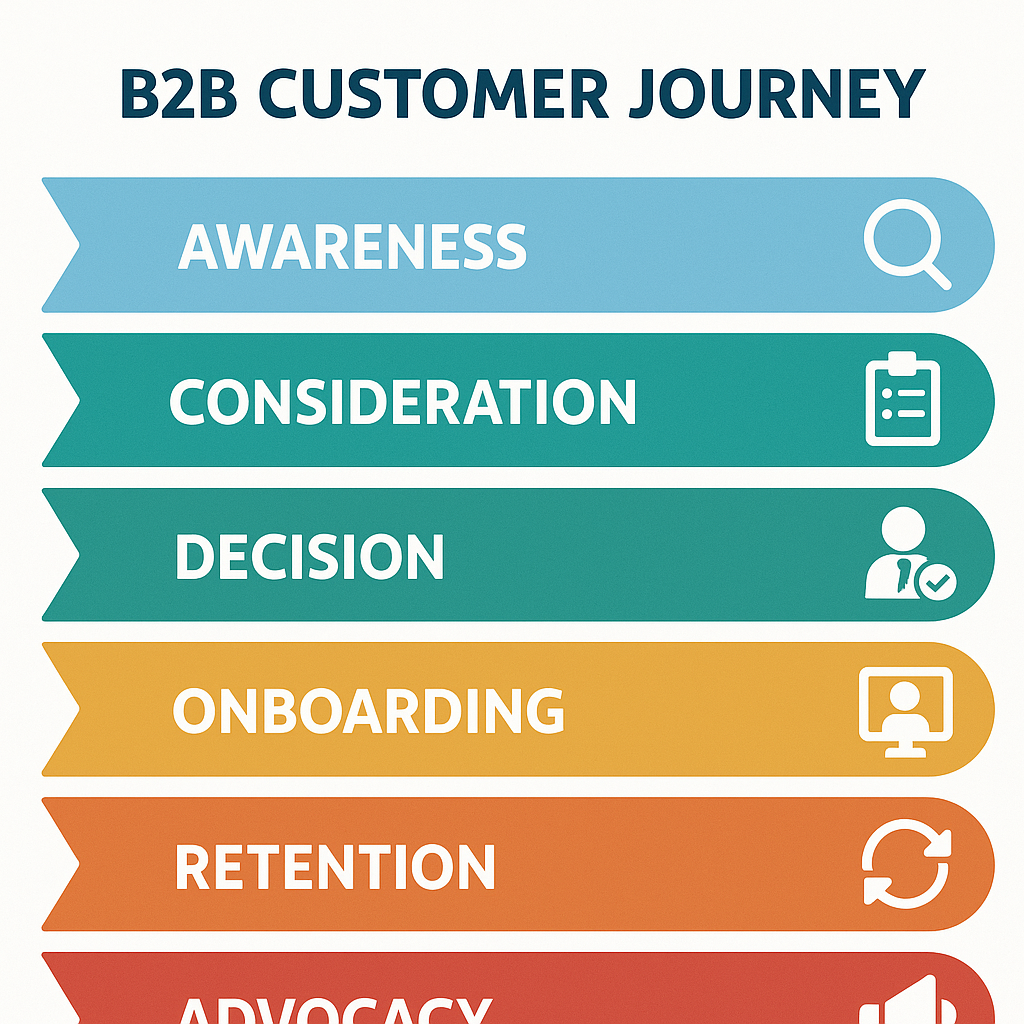
To truly harness the power of B2B customer journey mapping, you need to understand that the journey isn’t a single, monolithic entity. It's a series of distinct stages, each with its own unique customer goals, actions, touchpoints, and metrics. Let's break them down, and I’ll give you the inside scoop on what to focus on at every turn.
The Awareness Stage
This is the very beginning. Your potential customer has a problem or a need, but they might not even know your solution exists, or that your specific type of solution is what they require.
- Customer Goal: Problem recognition, initial information gathering, understanding a challenge they face.
- Customer Actions: They're likely doing broad online searches ("how to improve sales efficiency," "best CRM for small business," "challenges with data management"). They're consuming high-level content like general blog posts, industry reports, and maybe dipping their toes into social media discussions. Peer recommendations and word-of-mouth are also powerful here.
- Your Touchpoints: This is where your SEO-optimized website is paramount. Your content marketing efforts (blog posts, infographics, basic explainer videos) should be educational and problem-focused, not overtly salesy. A strong social media presence, targeted digital ads (think LinkedIn), and PR mentions also play a significant role.
- Metrics to Track: Website traffic, impressions, social media engagement, content downloads (e.g., top-of-funnel e-books).
- Pro Tip: At this stage, your goal isn't to sell, it's to educate and establish authority. Provide immense value. Be the go-to resource for their problems, even if they don't know your product yet. Think about it: when someone searches for "how to increase lead quality," you want your helpful blog post to pop up first. This is where semantic SEO becomes crucial – understanding the intent behind their broad queries and providing comprehensive answers.
The Consideration Stage
Okay, your prospect now understands their problem and is actively looking for solutions. They know there are options, and they're evaluating them.
- Customer Goal: Solution evaluation, comparing options (yours vs. competitors, or different types of solutions), understanding features, benefits, and how a solution fits their specific context.
- Customer Actions: They’re diving deeper into your content. They might download whitepapers, attend webinars, request product demos, read detailed case studies, or sign up for free trials. They're doing serious competitor analysis and maybe even reaching out to industry peers for advice.
- Your Touchpoints: This is where your email marketing sequences become critical for nurturing. Your content should shift to more detailed resources like expert guides, comparative analyses, and in-depth product pages. Webinars and interactive tools are great for demonstrating value. Sales outreach might begin, but it should be highly personalized and value-driven, not pushy.
- Metrics to Track: Marketing Qualified Leads (MQLs), conversion rates on lead magnet downloads, demo requests, engagement with email campaigns, time spent on key product pages.
- Pro Tip: Your sales team needs to be equipped with relevant content and insights from the marketing team. Sales and marketing alignment is absolutely non-negotiable here. When sales and marketing work hand-in-hand, they can generate up to 208% more revenue from marketing efforts and shorten sales cycles. Make sure your sales team has easy access to all the content marketing creates. If your teams are out of sync, check out our insights on The B2B Marketer's Graveyard: 7 Common Mistakes Killing Your Results to avoid pitfalls.
The Decision Stage
This is the moment of truth. Your prospect has narrowed down their options and is now ready to make a final choice. They’re evaluating vendors, assessing fit, and getting ready to commit.
- Customer Goal: Vendor selection, finalizing the purchase, ensuring the solution meets all their specific requirements, and getting approval from all stakeholders.
- Customer Actions: This stage involves intense scrutiny. They're likely requesting detailed proposals, engaging in negotiations, reviewing contracts, asking for specific implementation plans, and conducting final due diligence. They might also be checking references or asking for proof-of-concept offers. Remember, in B2B, this isn't just one person; it's often a buying committee with various roles (economic buyer, user buyer, technical buyer, champion).
- Your Touchpoints: This is heavily sales-driven, but still requires robust marketing support. Think personalized proposals, in-depth sales calls, live product demos, testimonials from similar clients, comprehensive case studies, and clear communication with legal and finance teams. Your website should host easily accessible pricing information (if applicable) and clear "contact sales" or "request a quote" options.
- Metrics to Track: Sales Qualified Leads (SQLs), closed-won deals, sales cycle length, proposal acceptance rates.
- Pro Tip: Don’t underestimate the power of your existing customer base here. Peer reviews and testimonials from satisfied clients can be the final push a prospect needs. Make sure your sales team has a treasure trove of these. Also, streamline your contracting and onboarding paperwork. Friction at this stage can kill a deal, even if the prospect is 99% convinced. For ways to ensure your sales efforts align with customer needs, our guide on Account Based Marketing Mastery provides valuable strategies.
The Onboarding & Adoption Stage

The deal is closed – fantastic! But the journey is far from over. This is where you transform a new customer into a successful user and, eventually, an enthusiastic advocate. Poor onboarding is a silent killer of B2B relationships.
- Customer Goal: Successful implementation, understanding how to use your product or service effectively, realizing the promised value, and integrating your solution into their existing workflows.
- Customer Actions: Attending training sessions, setting up their accounts, migrating data, integrating your solution with other tools, asking support questions, and exploring features.
- Your Touchpoints: Dedicated onboarding specialists, comprehensive support documentation (knowledge base, FAQs), video tutorials, proactive outreach from a customer success manager, and in-app guides. Regular check-ins are crucial.
- Metrics to Track: Time-to-value (how quickly they see initial results), feature adoption rate, initial customer satisfaction surveys (CSAT), usage metrics, support ticket volume.
- Pro Tip: A staggering 55% of customers will stop using a product they don't understand, and 75% of users abandon a product within the first week if they struggle during onboarding. This is a critical stage where you can either solidify or sabotage the relationship. Invest in clear, comprehensive, and accessible onboarding resources. Leverage AI enablement here to personalize training paths or provide instant support. This can be the difference between a one-time sale and a multi-year partnership.
The Retention & Advocacy Stage
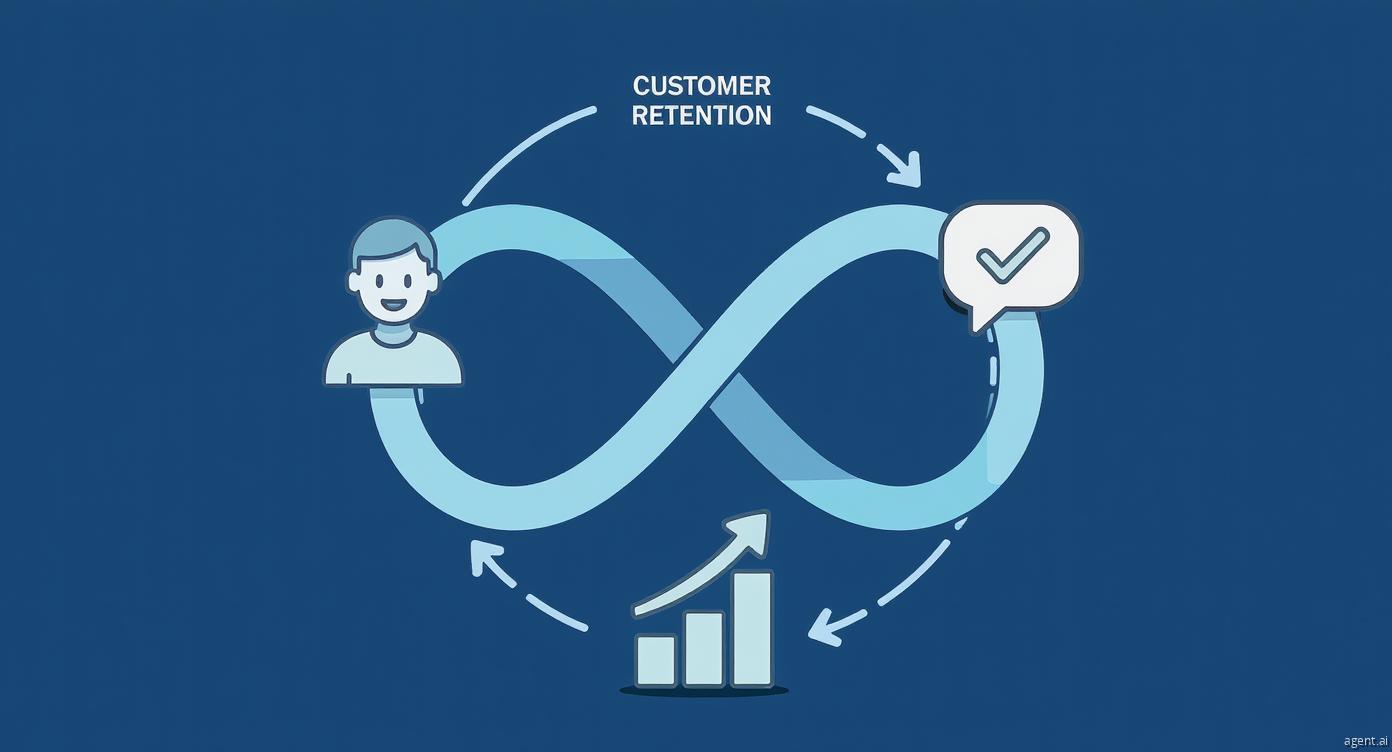
This is the ultimate goal. You’ve acquired the customer, they’re onboarded, and now you want to keep them, grow their business with you, and turn them into your loudest cheerleaders.
- Customer Goal: Ongoing value realization, continued success with your solution, renewal of services, exploring opportunities for expansion, and potentially recommending your business to others.
- Customer Actions: Regular usage of your product/service, seeking advanced support, providing feedback (positive or negative), participating in customer communities, attending webinars on advanced features, and (hopefully!) referring new clients.
- Your Touchpoints: Proactive customer success check-ins, product update announcements, exclusive content for existing clients, loyalty programs, referral incentives, community forums, and opportunities for case studies or testimonials.
- Metrics to Track: Churn rate, Net Promoter Score (NPS), upsell/cross-sell rates, customer lifetime value (CLV), renewal rates, and the number of referrals.
- Pro Tip: It costs anywhere from 5 to 25 times more to acquire a new customer than it does to retain an existing one. Let that sink in. Investing in retention is one of the smartest B2B growth strategies you can employ. Delight your current customers, and they will become your most powerful marketing asset. Building strong relationships post-purchase also creates opportunities for higher-value sales – existing customers are 50% more likely to try a new product from you. Consider an automated workflow to check in with inactive users or offer training for new features. For more on ensuring long-term success, delve into Beyond the Quick Win: Crafting a Long-Term B2B Growth Strategy for Enduring Success.
How to Build Your B2B Customer Journey Map: A Step-by-Step Guide
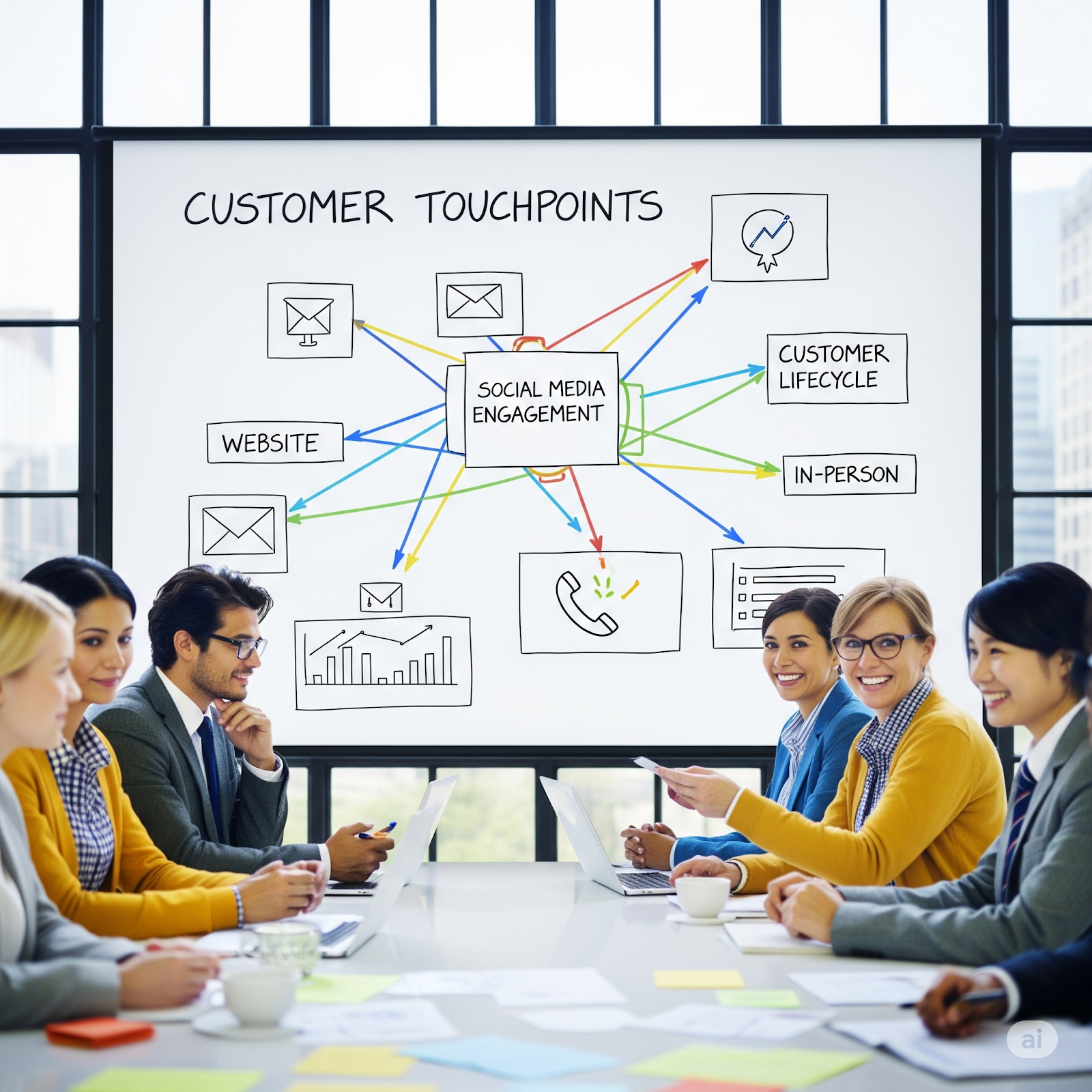
Alright, you’re convinced. You understand the "why." Now for the "how." Building a B2B customer journey map isn't about guesswork; it's a systematic process that combines research, empathy, and strategic thinking. Don't worry, it's not as daunting as it sounds, and the payoff is immense.
Define Your Objectives
Before you even think about drawing lines and boxes, ask yourself: What specific problem are you trying to solve with this map? Are you aiming to:
- Increase B2B lead generation rates from a specific channel?
- Reduce churn in the first 90 days after onboarding?
- Improve customer satisfaction scores at the support stage?
- Shorten your sales cycle for enterprise clients?
Having clear, measurable objectives will keep your mapping efforts focused and ensure you're not just creating a pretty diagram, but a powerful tool for change. Remember, if you don't know what success looks like, you'll never know if you've achieved it.
Create Detailed B2B Customer Personas
This is the foundation of your map. You can't understand a journey if you don't know who's taking it. In B2B, this is more complex than B2C because you're often dealing with multiple stakeholders within a single account. You'll need separate personas for:
- The Champion: The person who first feels the pain and champions your solution internally.
- The Decision Maker: The executive with budget authority.
- The End User: The person who will actually use your product daily.
- The Influencer: Others who advise the decision-making process (e.g., IT, legal).
Go beyond demographics. For each persona, delve into:
- Role & Responsibilities: What do they do? What are their daily tasks?
- Goals & Motivations: What are they trying to achieve in their role and for their company?
- Pain Points & Challenges: What keeps them up at night? What problems are they actively trying to solve?
- Information Sources: Where do they go for information (industry publications, social media, peers, analysts)?
- Decision-Making Power: What influence do they have in the buying process?
Pro Tip: Don't just guess at these. Conduct qualitative research (interviews with your sales team, customer success, and even existing clients) and quantitative data analysis (from your CRM, website analytics, and marketing automation platforms). Talk to the people who interact with your customers daily – they hold a goldmine of insights. Our guide on how to build a high-performing B2B marketing team emphasizes the importance of cross-functional collaboration, which is key for persona development.
Identify All Touchpoints (Online & Offline)
Now, list every single point of interaction a customer has with your brand. Think broadly. This isn’t just your website or a sales call. It includes:
- Digital: Your website, blog, social media profiles, email campaigns, online ads, webinars, chatbots, review sites, third-party industry forums.
- Human: Sales calls, customer support interactions, in-person meetings, industry events, conferences.
- Product: Your software interface, onboarding flows, documentation, product updates.
You might end up with what looks like a "spaghetti bowl" of interactions, but that's okay. The goal here is comprehensive capture. You'll refine it later. This comprehensive view helps you develop an effective growth marketing stack that covers all bases.
Map the Journey & Uncover Pain Points/Opportunities
This is where the magic happens. Take your personas and your list of touchpoints, and plot them onto your journey map. For each stage (Awareness, Consideration, Decision, Onboarding, Retention, Advocacy), ask:
- What is the customer doing at this stage? (e.g., searching, downloading, calling)
- What are they thinking? (e.g., "Is this solution right for us?", "How do we get buy-in?")
- What are they feeling? (e.g., excited, frustrated, overwhelmed, confident)
- What are their pain points? (e.g., "Information is fragmented," "Support takes too long," "The demo was too technical")
- What opportunities exist for us to improve their experience or move them forward?
Visualize this. You can use dedicated journey mapping software, or even a robust spreadsheet or collaborative whiteboard tools. The key is to see the flow and identify where the journey breaks down, where there are gaps in your content or support, and where you can delight the customer.
Validate with Data & Feedback
Don't let your map become a theoretical exercise. It needs to be grounded in reality.
- Quantitative Data: Use your website analytics (Google Analytics 4 is a powerful tool here), CRM data, and marketing automation reports to confirm your assumptions. Are people actually dropping off where you think they are? Is a particular content asset performing as expected at a specific stage?
- Qualitative Feedback: Conduct surveys, interviews, and usability tests with real customers. Ask them about their experiences. Their unfiltered insights are invaluable.
Iterate and Optimize
Here’s the most crucial part: a customer journey map is never finished. The B2B landscape, customer expectations, and your own offerings are constantly evolving.
- Regular Review: Schedule regular reviews (quarterly, biannually) to analyze the effectiveness of your changes.
- Continuous Improvement: Use your data and feedback to make continuous adjustments. Is that new webinar improving conversions? Did streamlining the onboarding process reduce churn?
Emphasize a culture of continuous improvement. This is where AI enablement and automation truly shine, helping you gather data, identify patterns, and implement changes with unprecedented speed.
Leveraging AI & Automation for Smarter B2B Journey Mapping
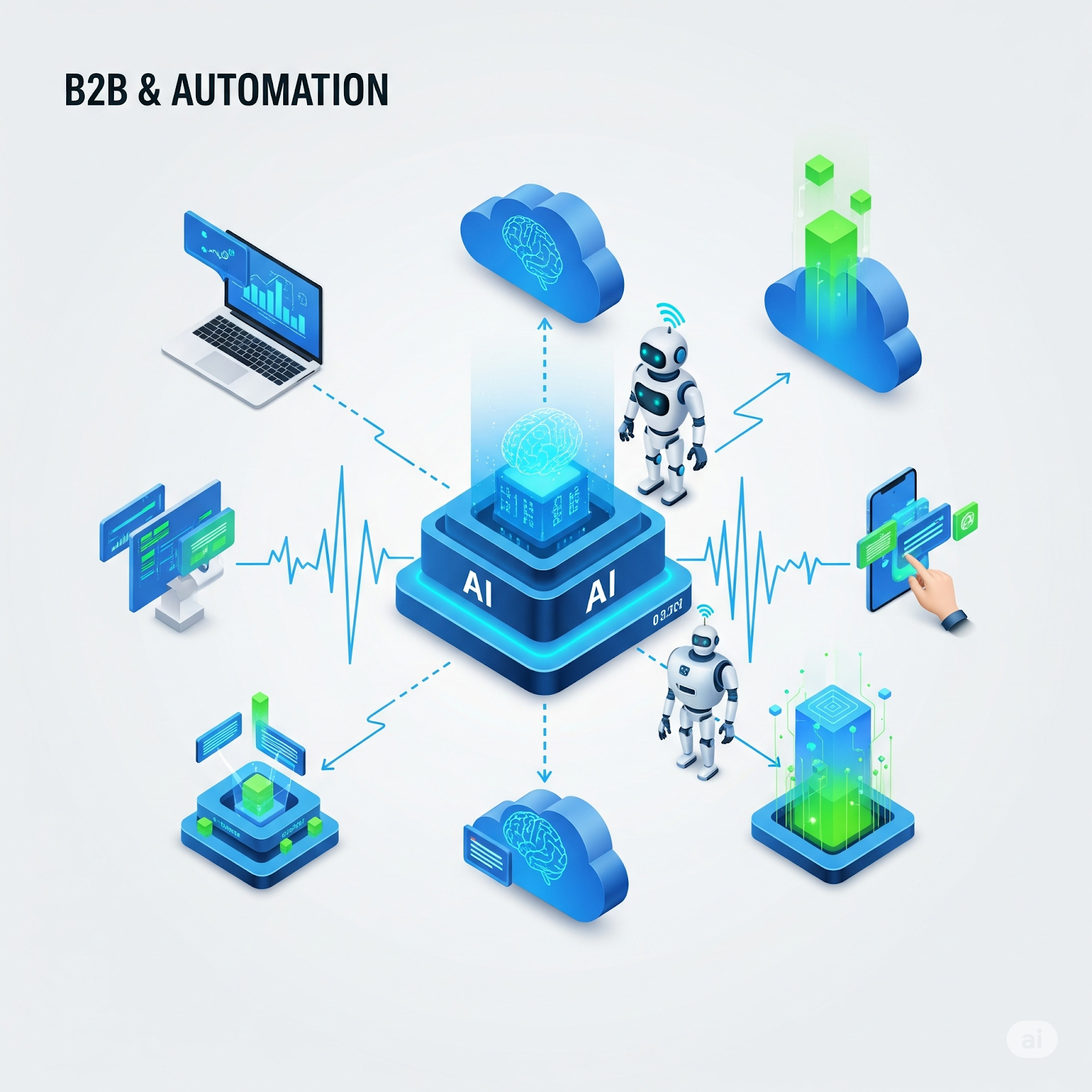
Okay, so you've built your map. You've uncovered the friction points and golden opportunities. Now, how do you supercharge this process and move beyond manual insights? The answer, my friend, lies in the intelligent integration of AI and automation. This isn't just about efficiency; it's about gaining a competitive edge that was unimaginable just a few years ago.
AI for Deeper Insights
Forget sifting through mountains of data. AI-powered tools can do the heavy lifting, providing insights that human analysis alone would miss or take weeks to uncover.
- Predictive Analytics: Imagine knowing before a customer even shows signs of dissatisfaction that they're at risk of churning. AI can analyze historical behavior patterns to predict churn risks, identify upsell or cross-sell opportunities, and even forecast which leads are most likely to convert. This means you can proactively intervene and nurture those relationships.
- Sentiment Analysis: Your customers are talking – in support tickets, chat logs, social media mentions, and survey responses. AI can analyze these unstructured text data points to gauge customer sentiment at various touchpoints. Is there a recurring theme of frustration around a specific feature? Are prospects showing positive emotions during your demos but negative ones during the proposal phase? This level of emotional insight is critical for fine-tuning your journey.
- Automated Data Collection & Pattern Recognition: AI tools seamlessly integrate with your CRM, marketing automation platforms, and website analytics. They automatically collect and consolidate data from disparate sources, identifying complex behavioral patterns and trends across the entire customer journey that would be impossible for a human to spot. This unified view is essential for a truly data-driven B2B marketing strategy. For a deeper dive into how AI is changing the game, check out The Future of B2B Marketing: Embracing AI and Automation.
Pro Tip: Don't get bogged down in tool selection paralysis. Start by identifying the specific insights you need. Are you looking to improve lead scoring? HubSpot Marketing Hub, Salesforce Einstein, or even Google Analytics 4 (GA4) with its predictive capabilities can be great starting points. If you're managing complex, multi-touchpoint journeys, platforms like Optimove or Adobe Experience Platform offer robust AI-driven features. The key is to leverage AI to ask better questions and get faster, more accurate answers from your data.
Automating Touchpoints & Personalization
Once you understand the journey, AI and automation allow you to act on those insights at scale, delivering personalized experiences without constant manual intervention.
- Dynamic Content Delivery: Based on a customer's journey stage, their persona, and their specific actions, automation platforms can dynamically deliver the most relevant content. A prospect who just downloaded a whitepaper on "AI in B2B" might automatically receive an email series on AI-powered efficiency: Automate your B2B workflows for explosive growth.
- Automated Lead Nurturing Sequences: Beyond simple drip campaigns, AI-powered automation can trigger complex workflows based on engagement, lead score changes, or specific buyer actions, ensuring prospects receive the right message at the right time.
- AI-Powered Chatbots & Virtual Assistants: These aren't just for basic FAQs anymore. Advanced chatbots can guide prospects through initial qualification, answer complex product questions, schedule demos, and provide instant support, ensuring no inquiry goes unanswered and reducing friction. This is a game-changer for B2B customer experience.
Custom Software Development for Seamless Journeys
Sometimes, off-the-shelf solutions simply can't provide the level of integration or customization needed to create a truly seamless customer journey. This is particularly true for complex B2B sales processes or unique service delivery models.
- Developing Bespoke Platforms: For businesses with specific needs, custom software development can be the answer. This could involve building custom CRM integrations, bespoke lead management systems, or tailored customer portals that unify disparate data points and provide a truly holistic customer view.
- Integrating Disparate Systems: Many B2B companies struggle with data silos – their sales, marketing, and customer service teams use different systems that don't talk to each other. Custom software can act as the glue, integrating these systems to create a single source of truth, ensuring every team member has the complete customer picture. This leads to better communication, smoother handoffs, and a dramatically improved customer experience. This is precisely where Growthmak.com excels, building solutions that make your customer journey flow like a well-oiled machine. Consider how No-Code Custom Software Drives Efficiency and Innovation in B2B workflows.
Conclusion: Your Roadmap to Sustainable B2B Growth
So, there you have it. The secret weapon for sustainable B2B growth in the digital age isn't some fleeting trend or a magic bullet. It's the meticulous, empathetic, and data-driven process of B2B customer journey mapping.
We've walked through why this isn't just a "nice-to-have" but a strategic imperative: it puts you firmly in your customer's shoes, allowing you to identify friction, capitalize on opportunities, and build relationships that stand the test of time. From optimizing your B2B lead generation and supercharging your sales and marketing alignment, to boosting customer retention and making truly data-driven decisions, understanding every touchpoint of your buyer's path is the key.
In today's hyper-competitive and increasingly digital B2B landscape, ignoring the customer journey is like navigating a complex city without a map – you might get somewhere eventually, but it will be slow, inefficient, and fraught with missed opportunities. By embracing journey mapping, especially with the power of AI enablement and smart automation, you transform your business from reactive to proactive, building a foundation for unparalleled success.
Ready to stop guessing and start growing with a clear, actionable roadmap? Don't just acquire customers; cultivate lasting, profitable relationships that fuel continuous growth.
Don't let your competitors get ahead by simply hoping for growth. Let's map out your path to success, together. Contact Growthmak.com today for a personalized consultation and unlock your business's true potential.
Get Started with Growthmak Today!
Unlock your marketing potential with our expert team.





.svg)

